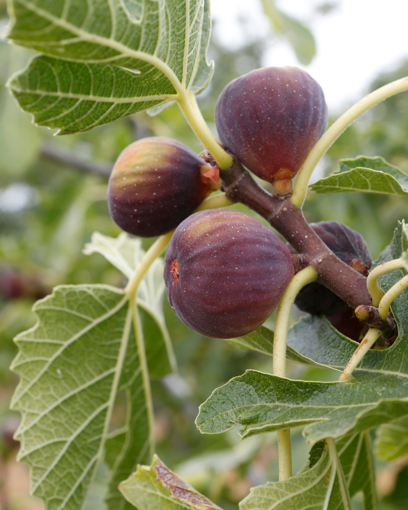For my project, I wanted to combine two of my major interests; plants and Latin. Besides the obvious connection between them — that plants’ scientific names often derive directly from their Roman names –there is a quirk about the Latin language that has always fascinated me. Despite many appearances to the contrary, the name of (almost) every tree (Latin: arbor) in Latin is in the feminine gender. Most Latin nouns in the second declension, ending in –us, are masculine — such as arcus, “bow” or “arch”, that gives Spanish arco, likewise masculine. But take the word pinus, which means “pine tree”. Its Spanish descent is pino. Looks perfectly masculine, right? While over the centuries Spanish speakers took the word’s form at face value, treating it as masculine, in Latin the word is feminine. A tall pinus is alta, not alto.
What is it about trees that the Latins saw as feminine? Why confuse what generations of Romance speakers from Portugal to Romania saw as obvious? I was intrigued at this strange feature of the ancient language I have made it my occupation to study, even more so because among the so many unique traits of Latin that have been passed to its descendants, it is one of the few that was lost — utterly lost. Not a single one of the dozens of Romance languages treat masculine-appearing tree names as feminine.
There isn’t an obvious reason why tree names are feminine in Latin, and in my investigation into the occurrence of over twenty different tree names in the corpus of Classical Latin, I didn’t find one. Yet it isn’t just grammar that gives trees a place of special prominence for those who study Latin. In my investigations, I discovered a beautiful and diverse literature in which trees take the center stage. The Romans loved trees. They delighted to walk in orchards and gardens, relished ripe figs and peaches, and used them for purposes as wide-ranging as ship-building to traditional medicine. In Latin literature, trees branch into campy romance poetry and heroic epic; they are the punchline of scathing roasts and the ingredients in the graveyard brews of evil witches. Through the lens of trees, a wide-ranging panorama of ancient Roman literature is manifest.
In this project you will be able to scroll through an orchard of Latin poetry. Walk through it at your leisure, pausing to linger at the trees that catch your eye. Perhaps you will recognize or rediscover within yourself some of the Romans’ love of trees, or perhaps learn something about ancient Roman culture. Enjoy!
The silver fir (Abies alba) (Latin: abies) is a towering coniferous tree endemic to the mountains of Europe. In Italy, it is only found on the high elevations of the peninsula: the Apennine Mountains that run like a spine down Italy and the northern Alps. It grows up to 200 feet, shooting straight up like an arrow to form one of the most impressively tall Italian trees. The excerpt from the Aeneid, Rome’s epic poem, below makes reference to both its mountain habits and amazing height. At this point in his epic poem, Vergil is telling about the fight between the native Italians and the Trojans led by Aeneas. The Italians’ party includes two heroes who are described as aequos abietibus, “equal to the firs” native to the mountains of Italy. I have chosen to translate aequos as “as tall as” considering by far the most impressive feature of this tree.

abies, abietis f. silver fir (Abies alba)
Vergil Aeneid 9.672-4
Pandarus et Bitias, Idaeo Alcanore creti,
quos Iovis eduxit luco silvestris Iaera
abietibus iuvenes patriis in montibus aequos.
Then came Pandarus and Bitias, the progeny of Idaean Alcanor,
Whom forest-dwelling Iaera brought up in a grove of Jupiter,
Two youths as tall as the firs on their native mountains.
There are many different maple species (Latin: acer) native to Italy, all in the genus Acer, such as the Sycamore Maple (Acer pseudoplatanus), Montpellier Maple (Acer monspessulanum), and the Italian Maple (Acer opalus). This tree is special in Latin because it is one of the only ones whose name is not feminine, instead being of the neuter gender, as shown in the excerpt below, where vile “cheap, vile, mean, contemptible” is declined in a way special to the neuter gender. In ancient Italy, as today, maple was one of the most common trees. While the ancient Romans were not blessed with the syrup-bearing Sugar Maple (Acer saccharum) of eastern North America, they had a variety of other uses for maple. The excerpt below comes from Ovid’s campy, over-the-top collection of love poetry, the Amores (“Loves”). In it, the author describes how he refuses to write long love notes to his mistress. Assured of his brevity’s success, he declares that he will dedicate the cheap maple-wood writing tablets to Venus, the goddess of love and beauty, as an offering.

acer, aceris n. maple (Acer sp.)
Ovid Amores 1.11.23-28
Quid digitos opus est graphio lassare tenendo?
hoc habeat scriptum tota tabella ‘VENI!’
non ego victrices lauro redimire tabellas
nec Veneris media ponere in aede morer.
subscribam: ‘VENERI FIDAS SIBI NASO MINISTRAS
DEDICAT, AT NUPER VILE FUISTIS ACER.’
What need is there to tire out the fingers by gripping the stylus?
Let the tablet’s message read this in entirety: “COME!”
I won’t delay to crown the victorious tablets with laurel
Nor to place them in the middle of Venus’s temple.
I shall write beneath them: “To Venus herself, I, Naso, dedicate
His faithful helpers, who were but recently mean maple.”
The European alder (Alnus glutinosa) (Latin: alnus) is a tree which likes to have its feet in the water. As you can see in the picture below, it is commonly found on riverbanks, ditches, swamps, and other wet or waterlogged places. It is able to grow in these habitats because of a species of nitrogen-fixing bacteria which enables it to take up nutrients from poor, wet soil. In the excerpt below, the poet Catullus is writing about a woman who freely has love affairs with other men. Whether her husband is genuinely ignorant or is turning a blind eye is left up for debate — sentiens could mean “knowing” or “feeling” or “sensing”, but considering the simile of the alder-tree, I translate it as “perceiving”, which I believe both trees and humans are capable of.

alnus, alni f. European alder (Alnus glutinosa)
Catullus Carmina 17.17-20
ludere hanc sinit ut lubet, nec pili facit uni,
nec se sublevat ex sua parte, sed velut alnus
in fossa Liguri iacet suppernata securi,
tantundem omnia sentiens quam si nulla sit
usquam. ⠀⠀
He allows her to play as she will, and he doesn’t think a hair of it,
Nor for his part does he stir himself, but just like an alder
Hamstrung by a Ligurian hatchet lying in a ditch,
He perceives everything as if it did not exist
Anywhere at all.
The box or boxwood (Buxus sempervirens) (Latin: buxus) is a species of tree which I can guarantee everyone reading this is familiar with, probably in the shapes of flamingoes and spheres. It is the most common species used for topiary and hedges. However, box also occurs as a wild tree, where its glossy green foliage and pale white-grey bark render it as beautiful in the forest as in any English garden. In the excerpt below, Ovid makes reference to the latter in a simile in the proto-Romeo and Juliet story of Pyramus and Thisbe. When Thisbe encounters her lover Pyramus, who has killed himself by accident thinking her dead (familiar?), the blood drains from her face, rendering her “paler than box”.

buxus, buxi f. Common boxwood (Buxus sempervirens)
Ovid Metamorphoses 4.133-6
dum dubitat, tremebunda videt pulsare cruentum
membra solum, retroque pedem tulit, oraque buxo
pallidiora gerens exhorruit aequoris instar, 135
quod tremit, exiguā cum summum stringitur aurā.
While she ponders, she sees, now trembling beating the bloody ground,
The limbs, and she brings her foot back, and wearing a face paler than boxwood
She shakes, the very image of the ocean’s water t
Trembling when its surface is grazed by the slightest breeze.
The Mediterranean cypress (Cupressus sempervirens) (Latin: cupressus – are you noticing a pattern between the scientific names and the Latin vernacular term?) was one of the most culturally significant trees to the Romans. We have the palm tree, which represents tropical bliss; the “old oak tree”, for wisdom and magic; the Romans had the cypress of DEATH. Everything morbid in Roman culture was associated with the cypress – from funerals to graveyards to black magic. It was used to fumigate the air during cremations, planted at graveyards, and as an ingredient in maleficent poisons – as seen in the excerpt below, coming from a fabulous narrative poem by Horace in which a coven of witches, led by the evil Canidia, conspires to murder a young boy for dark purposes. It was difficult to choose just one excerpt to illustrate the morbid symbolism of the cypress in the Roman imagination, showing just how powerful a cultural signifier it was.

cupressus, cupressi f. Mediterranean cypress (Cupressus sempervirens)
Horace Epodes 5.15-20
Canidia, brevibus implicata viperis
crinis et incomptum caput,
iubet sepulcris caprificos erutas,
iubet cupressos funebris
et uncta turpis ova ranae sanguine
plumamque nocturnae strigis
Canidia, the locks of her unkempt head
brat braided with little vipers,
Orders torn-up wild figs from the tombs,
Orders funereal cypresses,
And the eggs of a hideous frog anointed with blood,
And the feather of a nocturnal scops-owl.
Beloved in Mediterranean cuisine in ancient and modern times alike is the fig (Ficus carica) (Latin: ficus). The ancient Romans liked to eat figs raw and dried; they made sweets from them and boiled them down into syrup. Fig-trees predominated in Italian orchards and were one of Rome’s most important agricultural products. According to Roman mythology, the twins Romulus and Remus, the founders of Rome, were discovered by a she-wolf underneath a fig-tree. The gender of ficus was debated even by the experts of Latin grammar; while most considered it to be a typical feminine tree-name of the fourth declension, some authors insisted it was a masculine second-declension noun. This dispute, and the fact that “fig” is Latin slang for “hemorrhoid”, is the punchline of the invective poem by Martial below.

ficus, ficus f. or ficus, fici m. Common fig (Ficus carica)
Martial Epigrams 1.65
Cum dixi ficus, rides quasi barbara verba
et dici ficos, Laetiliane, iubes.⠀⠀
dicemus ficus, quas scimus in arbore nasci,
dicemus ficos, Laetiliane, tuos. ⠀⠀
When I say ficūs for “figs”, you laugh as if those are barbarian words
And you proscribe, Laetilianus, that I say ficos.
Let’s say ficūs for the ones which come from trees,
And say ficos for your “figs”, Laetilianus.
Project Reflection
I really enjoyed this project! In it, I was able to explore many aspects of Latin literature. I really enjoyed uncovering passages from a huge variety of works, and translating them. Translating out of Latin is my main engagement with the language, so translating into Latin from English was an extremely novel activity, despite the fact that I did some of that in my journalling. I did find it difficult — however, it was also very elucidating. I also enjoyed the web design aspect of this project. I hope that whoever reads this project comes away with a greater understanding of Latin literature, Roman culture, and tree-lore!